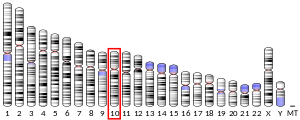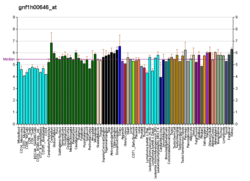LOXL4
Lysyl oxidase homolog 4 is an enzyme that in humans is encoded by the LOXL4 gene.[4][5]
This gene encodes a member of the lysyl oxidase gene family. The prototypic member of the family is essential to the biogenesis of connective tissue, encoding an extracellular copper-dependent amine oxidase that catalyses the first step in the formation of crosslinks in collagens and elastin. A highly conserved amino acid sequence at the C-terminus end appears to be sufficient for amine oxidase activity, suggesting that each family member may retain this function. The N-terminus is poorly conserved and may impart additional roles in developmental regulation, senescence, tumor suppression, cell growth control, and chemotaxis to each member of the family.[5]
References
- GRCh38: Ensembl release 89: ENSG00000138131 - Ensembl, May 2017
- "Human PubMed Reference:". National Center for Biotechnology Information, U.S. National Library of Medicine.
- "Mouse PubMed Reference:". National Center for Biotechnology Information, U.S. National Library of Medicine.
- Ito H, Akiyama H, Iguchi H, Iyama K, Miyamoto M, Ohsawa K, Nakamura T (Jun 2001). "Molecular cloning and biological activity of a novel lysyl oxidase-related gene expressed in cartilage". J Biol Chem. 276 (26): 24023–9. doi:10.1074/jbc.M100861200. PMID 11292829.
- "Entrez Gene: LOXL4 lysyl oxidase-like 4".
Further reading
- Molnar J, Fong KS, He QP, et al. (2003). "Structural and functional diversity of lysyl oxidase and the LOX-like proteins". Biochim. Biophys. Acta. 1647 (1–2): 220–4. doi:10.1016/s1570-9639(03)00053-0. PMID 12686136.
- Asuncion L, Fogelgren B, Fong KS, et al. (2002). "A novel human lysyl oxidase-like gene (LOXL4) on chromosome 10q24 has an altered scavenger receptor cysteine rich domain". Matrix Biol. 20 (7): 487–91. doi:10.1016/S0945-053X(01)00161-5. PMID 11691588.
- Mäki JM, Tikkanen H, Kivirikko KI (2002). "Cloning and characterization of a fifth human lysyl oxidase isoenzyme: the third member of the lysyl oxidase-related subfamily with four scavenger receptor cysteine-rich domains". Matrix Biol. 20 (7): 493–6. doi:10.1016/S0945-053X(01)00157-3. PMID 11691589.
- Strausberg RL, Feingold EA, Grouse LH, et al. (2003). "Generation and initial analysis of more than 15,000 full-length human and mouse cDNA sequences". Proc. Natl. Acad. Sci. U.S.A. 99 (26): 16899–903. Bibcode:2002PNAS...9916899M. doi:10.1073/pnas.242603899. PMC 139241. PMID 12477932.
- Holtmeier C, Görögh T, Beier U, et al. (2003). "Overexpression of a novel lysyl oxidase-like gene in human head and neck squamous cell carcinomas". Anticancer Res. 23 (3B): 2585–91. PMID 12894545.
- Kim MS, Kim SS, Jung ST, et al. (2004). "Expression and purification of enzymatically active forms of the human lysyl oxidase-like protein 4". J. Biol. Chem. 278 (52): 52071–4. doi:10.1074/jbc.M308856200. PMID 14551188.
- Ota T, Suzuki Y, Nishikawa T, et al. (2004). "Complete sequencing and characterization of 21,243 full-length human cDNAs". Nat. Genet. 36 (1): 40–5. doi:10.1038/ng1285. PMID 14702039.
- Gerhard DS, Wagner L, Feingold EA, et al. (2004). "The status, quality, and expansion of the NIH full-length cDNA project: the Mammalian Gene Collection (MGC)". Genome Res. 14 (10B): 2121–7. doi:10.1101/gr.2596504. PMC 528928. PMID 15489334.
- Rual JF, Venkatesan K, Hao T, et al. (2005). "Towards a proteome-scale map of the human protein-protein interaction network". Nature. 437 (7062): 1173–8. Bibcode:2005Natur.437.1173R. doi:10.1038/nature04209. PMID 16189514.
- Olsen JV, Blagoev B, Gnad F, et al. (2006). "Global, in vivo, and site-specific phosphorylation dynamics in signaling networks". Cell. 127 (3): 635–48. doi:10.1016/j.cell.2006.09.026. PMID 17081983.
- Shieh TM, Lin SC, Liu CJ, et al. (2007). "Association of expression aberrances and genetic polymorphisms of lysyl oxidase with areca-associated oral tumorigenesis". Clin. Cancer Res. 13 (15 Pt 1): 4378–85. doi:10.1158/1078-0432.CCR-06-2685. PMID 17671119.


